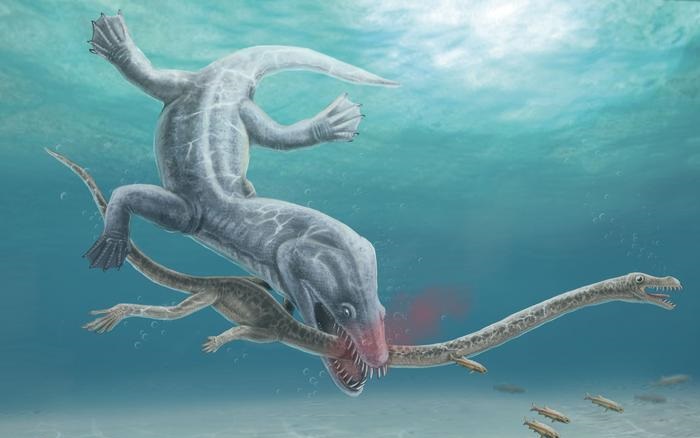These Triassic Reptiles’ Necks Were So Long They Lost Their Heads
Posted on Categories Discover Magazine

Tanystropheus, a strange marine reptile that lived alongside dinosaurs, has puzzled paleontologists since its discovery in the mid-1800s. At first, scientists mistook the species for flying reptiles, due to their extremely elongated neck bones. Only later did they realize that the vertebrae framed a neck so long that it looked like evolution was trying to create a cartoon.
Now, a new paper seeks to answer a nearly 170-year-old question: Wasn’t such a long and awkward neck a liability?
Just How Long was the Reptile’s Neck?
The larger Tanystropheus species was all neck: Of its 20 feet of length, including the tail, 10 feet of it was neck, which was three times the length of the torso. It also had 13 elongated vertebrae that held the proud column together. This sounds like a precious few until you hear that giraffes and humans share the same number of spinal bones (seven), although the former are much, much longer.
Opinions as to where these goofy reptiles lived have varied over the years. A 2020 study that CT scanned and then digitally reassembled skull fragments concluded that they must have lived underwater and not primarily on land. Tanystropheus, the paper says, wielded “fish trap” teeth, and the skull was otherwise streamlined for aquatic hunting.
A Triassic Horror Show
While handy for snatching prey, paleontologists have long surmised that the right predator could swim up and snap the neck in two. In 1830, Pioneering paleontologist Henry De la Beche even made a lithograph of this scenario that showed an ichthyosaur chomping onto a long-necked, water-dwelling plesiosaur that resembles a Tanystropheus.
Read More: Did a Swimming Reptile Predate the Dinosaurs?
A small team that includes paleontologists Stephan Spiekman and Eudald Mujal examined two unusual Tanystropheus specimens at the Paleontological Museum of the University of Zurich and thought they had found evidence of a proper beheading. Both fossils consisted of well-preserved heads connected to only part of the neck, as if severed in a grisly act. And the researchers found traces of the predators’ teeth on the fossils, from attacks dating back more than 240 million years.
“The fact that the head and neck are so undisturbed suggests that when they reached the place of their final burial, the bones were still covered by soft tissues like muscle and skin,” says Mujal in a press release. “The predators were less interested in the skinny neck and small head and instead focused on the much meatier parts of the body.”
The Big and Small Tanystropheus
The two specimens were quite different, although both died in the same manner. One was smaller, only about five feet in length, and given its size, it likely fed on shrimp and other soft-shelled animals. The other species would have measured up to 20 feet and consumed fish and squid. Both likely spent most of their time in the water, where they laid in wait for their next meal.
Long necks have downsides, but evolution selected them for more than 175 million years, during which such reptiles were common.
“In a very broad sense, our research once again shows that evolution is a game of trade-offs,” Spiekman says in a press release. “The advantage of having a long neck clearly outweighed the risk of being targeted by a predator for a very long time.”
Read More: How the Triassic Extinction Helped Dinosaurs Take Over the Planet